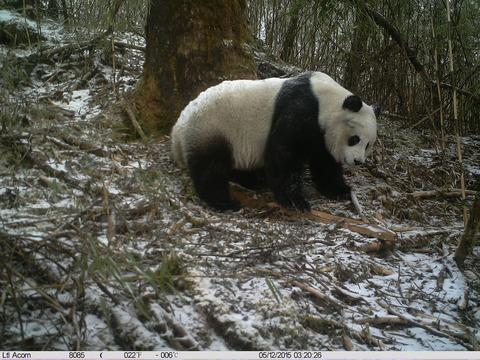当前位置:
X-MOL 学术
›
Microb. Biotechnol.
›
论文详情
Our official English website, www.x-mol.net, welcomes your
feedback! (Note: you will need to create a separate account there.)
Geographic pattern of antibiotic resistance genes in the metagenomes of the giant panda
Microbial Biotechnology ( IF 4.8 ) Pub Date : 2020-08-18 , DOI: 10.1111/1751-7915.13655 Ting Hu 1 , Qinlong Dai 2, 3 , Hua Chen 4 , Zheng Zhang 1 , Qiang Dai 5 , Xiaodong Gu 6 , Xuyu Yang 6 , Zhisong Yang 7 , Lifeng Zhu 1
Microbial Biotechnology ( IF 4.8 ) Pub Date : 2020-08-18 , DOI: 10.1111/1751-7915.13655 Ting Hu 1 , Qinlong Dai 2, 3 , Hua Chen 4 , Zheng Zhang 1 , Qiang Dai 5 , Xiaodong Gu 6 , Xuyu Yang 6 , Zhisong Yang 7 , Lifeng Zhu 1
Affiliation

|
The rise in infections by antibiotic‐resistant bacteria poses a serious public health problem worldwide. The gut microbiome of animals is a reservoir for antibiotic resistance genes (ARGs). However, the correlation between the gut microbiome of wild animals and ARGs remains controversial. Here, based on the metagenomes of giant pandas (including three wild populations from the Qinling, Qionglai and Xiaoxiangling Mountains, and two major captive populations from Yaan and Chengdu), we investigated the potential correlation between the constitution of the gut microbiome and the composition of ARGs across the different geographic locations and living environments. We found that the types of ARGs were correlated with gut microbiome composition. The NMDS cluster analysis using Jaccard distance of the ARGs composition of the gut microbiome of wild giant pandas displayed a difference based on geographic location. Captivity also had an effect on the differences in ARGs composition. Furthermore, we found that the Qinling population exhibited profound dissimilarities of both gut microbiome composition and ARGs (the highest proportion of Clostridium and vancomycin resistance genes) when compared to the other wild and captive populations studies, which was supported by previous giant panda whole‐genome sequencing analysis. In this study, we provide an example of a potential consensus pattern regarding host population genetics, symbiotic gut microbiome and ARGs. We revealed that habitat isolation impacts the ARG structure in the gut microbiome of mammals. Therefore, the difference in ARG composition between giant panda populations will provide some basic information for their conservation and management, especially for captive populations.
中文翻译:

大熊猫宏基因组中抗生素抗性基因的地理格局
抗生素耐药细菌感染的增加在全世界范围内构成了严重的公共卫生问题。动物的肠道微生物组是抗生素抗性基因(ARG)的储存库。然而,野生动物肠道微生物群与 ARG 之间的相关性仍存在争议。在此,基于大熊猫的宏基因组(包括来自秦岭、邛崃山和小相岭的三个野生种群,以及来自雅安和成都的两个主要圈养种群),我们研究了肠道微生物组的构成与大熊猫的组成之间的潜在相关性。 ARG 跨越不同的地理位置和生活环境。我们发现 ARG 的类型与肠道微生物组的组成相关。使用杰卡德距离对野生大熊猫肠道微生物组的 ARG 组成进行的 NMDS 聚类分析显示出基于地理位置的差异。圈养也对 ARG 组成的差异产生影响。此外,我们发现,与其他野生和圈养种群研究相比,秦岭种群的肠道微生物组组成和 ARG(梭菌和万古霉素抗性基因比例最高)表现出极大的差异,这一点得到了先前大熊猫全基因组的支持。测序分析。在这项研究中,我们提供了一个关于宿主群体遗传学、共生肠道微生物组和 ARG 的潜在共识模式的例子。我们发现栖息地隔离会影响哺乳动物肠道微生物组中的 ARG 结构。因此,大熊猫种群间ARG组成的差异将为大熊猫特别是圈养种群的保护和管理提供一些基础信息。
更新日期:2020-08-18
中文翻译:

大熊猫宏基因组中抗生素抗性基因的地理格局
抗生素耐药细菌感染的增加在全世界范围内构成了严重的公共卫生问题。动物的肠道微生物组是抗生素抗性基因(ARG)的储存库。然而,野生动物肠道微生物群与 ARG 之间的相关性仍存在争议。在此,基于大熊猫的宏基因组(包括来自秦岭、邛崃山和小相岭的三个野生种群,以及来自雅安和成都的两个主要圈养种群),我们研究了肠道微生物组的构成与大熊猫的组成之间的潜在相关性。 ARG 跨越不同的地理位置和生活环境。我们发现 ARG 的类型与肠道微生物组的组成相关。使用杰卡德距离对野生大熊猫肠道微生物组的 ARG 组成进行的 NMDS 聚类分析显示出基于地理位置的差异。圈养也对 ARG 组成的差异产生影响。此外,我们发现,与其他野生和圈养种群研究相比,秦岭种群的肠道微生物组组成和 ARG(梭菌和万古霉素抗性基因比例最高)表现出极大的差异,这一点得到了先前大熊猫全基因组的支持。测序分析。在这项研究中,我们提供了一个关于宿主群体遗传学、共生肠道微生物组和 ARG 的潜在共识模式的例子。我们发现栖息地隔离会影响哺乳动物肠道微生物组中的 ARG 结构。因此,大熊猫种群间ARG组成的差异将为大熊猫特别是圈养种群的保护和管理提供一些基础信息。











































 京公网安备 11010802027423号
京公网安备 11010802027423号